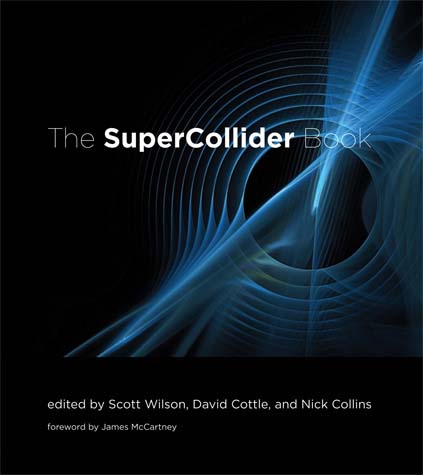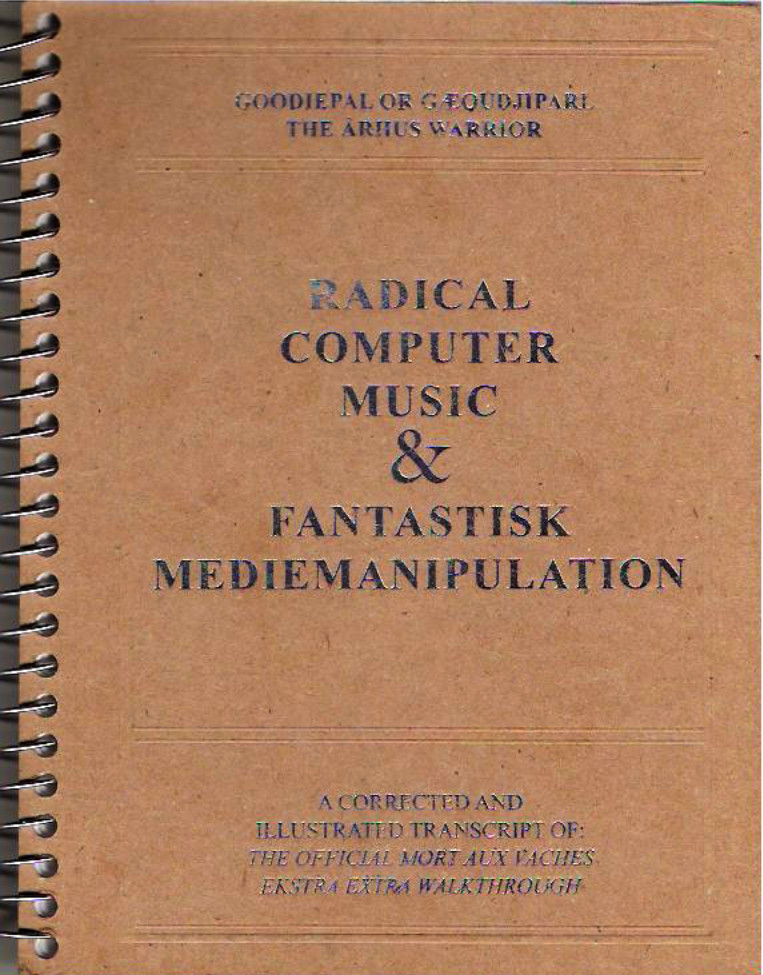Scott Wilson, David Cottle, Nick Collins (eds.): The SuperCollider Book (2011)
Filed under book | Tags: · code, computer music, microsound, music, programming, software, sonification, sound, sound art, sound synthesis

“SuperCollider is one of the most important domain-specific audio programming languages, with potential applications that include real-time interaction, installations, electroacoustic pieces, generative music, and audiovisuals. The SuperCollider Book is the essential reference to this powerful and flexible language, offering students and professionals a collection of tutorials, essays, and projects. With contributions from top academics, artists, and technologists that cover topics at levels from the introductory to the specialized, it will be a valuable sourcebook both for beginners and for advanced users.
SuperCollider, first developed by James McCartney, is an accessible blend of Smalltalk, C, and further ideas from a number of programming languages. Free, open-source, cross-platform, and with a diverse and supportive developer community, it is often the first programming language sound artists and computer musicians learn. The SuperCollider Book is the long-awaited guide to the design, syntax, and use of the SuperCollider language. The first chapters offer an introduction to the basics, including a friendly tutorial for absolute beginners, providing the reader with skills that can serve as a foundation for further learning. Later chapters cover more advanced topics and particular topics in computer music, including programming, sonification, spatialization, microsound, GUIs, machine listening, alternative tunings, and non-real-time synthesis; practical applications and philosophical insigh”s from the composer’s and artist’s perspectives; and “under the hood,” developer’s-eye views of SuperCollider’s inner workings. A Web site accompanying the book offers code, links to the application itself and its source code, and a variety of third-party extras, extensions, libraries, and examples.”
Foreword by James McCartney
Publisher MIT Press, 2011
ISBN 0262232693, 9780262232692
756 pages
Review: Dave Phillips (Linux Journal).
PDF (removed on 2014-2-4 upon request of the publisher)
Code (ZIP)
Book resources (code, video examples)
Book errata
Goodiepal or Gaeoudjiparl The Århus Warrior: Radical Computer Music & Fantastisk Mediemanipulation (2009)
Filed under book | Tags: · computer music, game, music

“The term Radical Computer Music was coined by Goodiepal in relation to the Mort Aux Vaches Ekstra Extra compositional game scenario. It promotes an expanded dialogue between human beings and artificial and alternative intelligences as a way to transgress a condition of stagnation, according to Goodiepal prevailing in contemporary computer music and media art. The game scenario is an exercise in the creation of musical scores to challenge the mindset of ‘other’ intelligences, considering issues such as utopia, time, notation techniques, language, levels of unscannability, and the role of the composer.
Mort Aux Vaches Ekstra Extra was launched as an educational program at a special lecture given in April 2008 at the 5th Berlin Biennial for Contemporary Art, the work as such was first premiered in October 2007 at a solo exhibition at Andersen’s Contemporary in Copenhagen, Denmark.
Towards the end of 2008, Goodiepal created what he considers an expert panel consisting of members with various skills and backgrounds such as Andreas Hauer-Jensen, Anders Jørgen Mogensen, Uglemads, Martha Hviid and Tordis Berstrand. He has since taken the panel around Europe to help him lecture and perform and during the trips told them most of the secrets behind the Mort Aux Vaches Ekstra Extra game scenario and Radical Computer Music. Some of these ideas are also described in Radical Computer Music & Fantastisk Mediemanipulation: A Corrected and Illustrated Transcript of the Official Mort Aux Vaches Ekstra Extra Walkthrough published in 2009 and offered here for download.” (Wikipedia)
Publisher MPH/Pork Salad Press, Portland/Copenhagen, 2009
ISBN 9781934399125, 1934399124
76 pages
via Radio Web MACBA
video reading 1:21h
Radical Computer Music at Wikipedia
Peter Hoffmann: Music Out of Nothing? A Rigorous Approach to Algorithmic Composition by Iannis Xenakis (2009)
Filed under thesis | Tags: · algorithm, composing, composition, computer music, computing, electroacoustic music, listening, music, music theory, sound
“GENDY3 (1991) by Iannis Xenakis (1922-2001) is a piece of computer generated music. But it is more than just ‘computer music’. GENDY3 is the culmination of Xenakis’ lifelong quest for an ‘Automated Art’: a music entirely generated by a computer algorithm.
Being a radical instance of a pure algorithmic composition, GENDY3 is, in a precise mathematical sense, a computable music: every aspect of its sonic shape is defined by an algorithmic procedure called ‘Dynamic Stochastic Synthesis’ (‘Génération Dynamique Stochastique’, or GENDYN for short).
The GENDYN Project, started by the author in 1995/96 with a research at CEMAMu, then the composer’s research center near Paris, exploits this computability for developing and documenting the GENDYN concept, in order to understand its various ramifications and to make it accessible for further research and production. To this end, the author implemented Dynamic Stochastic Synthesis in a new program called the ‘New GENDYN Program’ which, in addition to ‘recomposing’ GENDY3 in real time, makes it possible to inspect and control the algorithmic composition process, thereby opening up new perspectives both in Computational Musicology and in computer music creation.
For music analysis purposes, GENDY3 has been completely resynthesized. The simulation of the genesis of GENDY3 ‘in vitro’ made possible by the New GENDYN Program permits the systematic exploration of the ‘decision space’ of the composition model, contributing to a deeper understanding of both its potentials and limitations, and the complex interaction between ‘material requirements’ and compositional freedom within which the composer navigated.
The study of the GENDYN compositions provokes many fundamental questions about computing, listening and understanding, of creation, interaction and computer music aesthetics. It is shown that Xenakis, unlike many computer music composers, had no ambition whatsoever to emulate traditional musical thinking with the computer. Instead he realized his sonic vision in an abstract physical model of sound pressure dynamics yielding higher-order musical structures as emergent epiphenomena. This unusual approach addresses the medium of electroacoustic algorithmic music, i.e. the physics of sound, as well as the computability of sound as subjects of artistic creation. This approach seems to the author to be of a higher value for the foundation of a ‘true’ computer art than the widespread ambition to emulate human creativity by computers and to build up an artificial brave new world of music.” (Abstract)
PhD thesis
Fakultät I – Geisteswissenschaften, Technische Universität Berlin
Vorsitzender: Stefan Weinzierl
Berichter: Christian Martin Schmidt
Berichter: Helga de la Motte-Haber
346 pages
PDF (updated on 2017-8-4)
Comment (1)
